|
The Prairie School Lands in Mission Hills
By Allen Hazard
May/June 2023
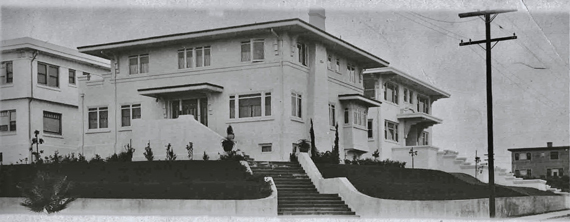 Three Prairie School houses by Melhorn and James Draper on Alameda Drive and Saint James Place, Mission Hills, were built between 1916 and 1917. Their regional design elements include rectangular layouts, stucco siding, flat roofs, and wide overhanging eaves.
Allen Hazard is a member of SOHO’s board of directors. Read more about his preservation actions and research.
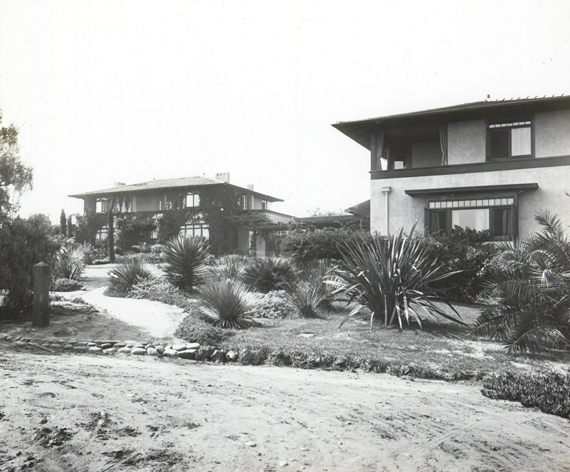 Hebbard & Gill designed San Diego’s first Prairie School houses for Alice Lee and Katherine Teats in 1905 along Seventh Avenue. Courtesy SOHO Collection |
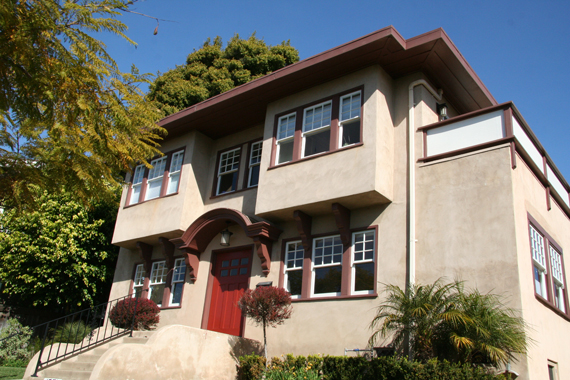 The 1913 Worthington House by Samuel Calvin at 1770 Fort Stockton Drive is a historically designated home in Mission Hills. The curved entrance canopy recalls the work of Chicago architect George Maher, and its lack of corner brackets is more representative of the Chicago Prairie School. |
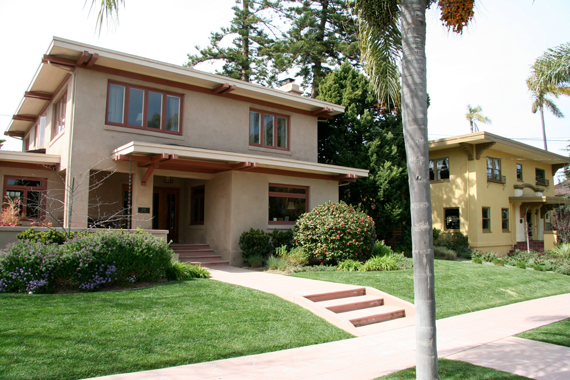 The 4100 block of Lark Street, or Prairie Row, in Mission Hills features six Prairie School homes. Seen here are the Joel Brown House (1916, left) and the Alberta Security Company/Martin V. Melhorn Spec House #2 built by Marvin V. Melhorn (1923). Both homes are listed on the City of San Diego portion of the California Historical Resources Inventory Database. |
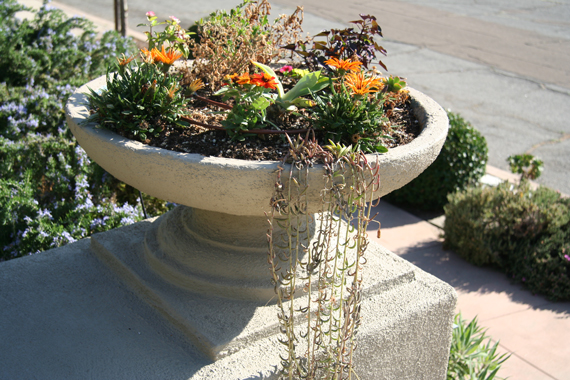 Important Prairie School artist Orlando Giannini is known nationally for his murals at Wright’s Oak Park, Illinois, home, and for glass mosaic fireplaces in homes designed by Maher and Wright. In San Diego, he lived (and may have designed) an Alameda Drive bungalow, where his Prairie School flower urn remains beside the front steps.
All photographs courtesy Allen Hazard Collection, except where otherwise noted.
|
The Midwestern Prairie School emerged from the Arts and Crafts movement as the most original form of American architecture, excepting Native American forms. Frank Lloyd Wright designed the first home with that evocative style name in 1901. Its visual characteristics—a low-hipped or flat roof, wide cantilevered eaves, ribbons of windows, and other strong horizontal elements—sprang from many influences. Among these were the Shingle Style, Louis Sullivan’s lessons in eliminating ornament, Japanese woodblock prints, and the writings of transcendentalists Emerson and Thoreau, and Whitman’s poetry. Chicago architects such as Wright, Walter Burley Griffin, Marion Mahony (who worked with Wright, then Griffin, and later married Griffin, becoming Marion Mahony Griffin), and others sought an authentic American Democratic architecture that was free of imitating European historical styles.
In San Diego, partners William Hebbard and Irving Gill designed the first Prairie School houses in 1905 for Alice Lee and Katherine Teats, along Seventh Avenue. More Prairie School homes soon appeared in the Bankers’ Hill, North Park, and Loma Portal communities, and the city of Escondido.
However, it was in San Diego’s Mission Hills that over 50 Prairie School homes were built there by architects and these builders: Samuel Calvin, Marvin V. Melhorn, and Nathan Rigdon, among others. Several of them had worked in progressive architectural offices in the Midwest and read national magazines such as Inland Architect, Western Architect, House Beautiful, and Ladies Home Journal, which featured Prairie School designs and ideas.
Founded in 1908 as a progressive and artistic community, Mission Hills attracted residents such as the writer Eloise Roorbach of Craftsman Magazine fame and other nationally known singers, poets, and artists who lived alongside architects, civic leaders, and businessmen. The Prairie School houses were inspired by their Midwestern cousins, synthesizing hybrid styles and aesthetics, including Arts and Crafts, Mission Revival, and Mediterranean Revival, and they were adapted to California’s climate.
Following World War I, progressive movements such as the Prairie School were incidental victims of a rapidly changing country. The wonderful flourishing of avant-garde art, music, literature, and architecture was over for the time being. Conformity had won over individuality, tradition won over an idea. However, these homes remain as an appealing visual record of their livability and value, both aesthetically and historically.
|
2025
2024
2023
2022
2021
2020
2019
2018
2017
2016
2015
|








